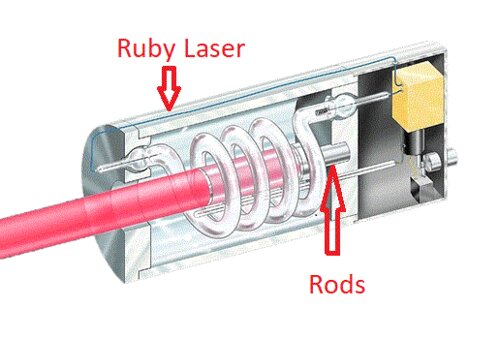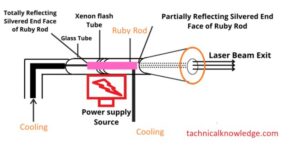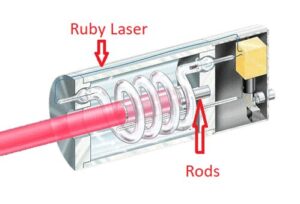
Ruby Laser Definition
The Ruby laser was used as the active medium in Maiman’s 1960 development of the solid-state laser known as the Ruby laser. Ruby is an aluminum oxide crystal. Where chromium ions are used to replace aluminum ions partially. Chromium ions are the substance that makes the ruby active. The energy of the chromium ions at that level is what gives the effect a long-lasting quality.
Three main components make up a ruby laser instrument:
- An active material (also called a laser medium) or active medium.
- A device or system that consists of 2 parallel plates covered in reflective material.
- Flash tubes are a power source and a tool for population inversion, and helical xenon is frequently used to create dynamic systems.
Ruby Laser Working and Construction
Constructing the Ruby Laser
When a chromium ion replaces some of the aluminum ion in aluminum oxide, it forms a ruby. Chromium ions are the substance that makes the ruby active. This chromium ion energy level is what contributes to the long-lasting effect. The quantity of chromium in a ruby crystal determines its color, either pink or red.
A specifically produced aluminum oxide crystal has around 0.05% of the atoms replaced by chromium. In certain furnaces, ruby crystals are formed, annealed, and formed into rods. These rods range in length from 2 cm to 30 cm and have a diameter of 0.5cm to 2 cm. The rod’s flat end sides are extremely precisely sanded and polished, and they are made exactly parallel.
On non-special plates, a reflective coating may occasionally be applied. However, directly on the Ruby Rod’s end faces. The road’s faces are silver, making one end face’s surface totally reflective. The opposite end face then starts to reflect some light. The partially reflective end face of a ruby rod usually lets between 10% and 25% of light through. Ruby Rod works as a resonant cavity because one end only reflects, and the other only partially reflects.
How the Ruby Laser Works
The ruby rod is positioned along the axis of a spiral xenon flash tube so that the helix will enclose it. The tube flashes for several milliseconds. The tube receives energy totaling many thousand joules throughout this time, with most of that energy going toward heating the apparatus.
The heat generated by the Ruby rod is dissipated by circulating liquid nitrogen. The extra energy is absorbed by the ruby and appears as blue and green radiation. These energy guarantees ensure that chromium ions are excited from their ground state to the excited energy state to achieve population inversion.

Incident photons of a 5500-nanometer wavelength produce the optical pumping. Chromium ions are raised from the ground position E1 to the more highly excited state E3. These iron atoms interact with the crystal lattice and spontaneously change to the metastable state E2, where they can stay for a longer time (3 x 10-3 seconds). This is called population inversion. This means that there are more chromium ions in the energy state E2 (the metastable state) than in the excited energy state E3. Therefore, an optical pumping source is used to create a population inversion.
Production of a Laser Beam
Through spontaneous emission of radiation, certain chromium ions transition from the metastable state E2 to the ground state E1. An emission of a photon of wavelength 6943 nm occurs at this transition.
This photon travels parallel to the axis of the Ruby rod and bounces off the reflecting ends of the optical resonator back and forth (or to and fro) until it stimulates an excited chromium ion. The photon released by the stimulated, excited chromium ion is in phase with the stimulating photon.
The term “laser transition” refers to the stimulated transition of the chromium ion from the metastable state E2 to the ground state E1. As these in-phase photons stimulate additional chromium ions, more photons are released. The in-phase pictures are amplified as a result of this procedure being repeated. As a result, a powerful and coherent laser beam is produced. It exits the optical resonator via the face, which is reflective.
Ruby Laser output
For population simulation, inversion is provided as a brief flasher or pulse of light in Ruby laser energy. As a result, the pulse laser nickname was given to the ruby laser.
Ruby Laser Spiking
A few nanoseconds are all it takes for an optical pumping source to provide the energy that keeps life going. When a crystal or rod is in its ground state and takes in a flash or pulse of light, which is measured by a ruby laser, this is called population inversion. By releasing 6943-nanometer laser light (or photons), the metastable condition vanishes. So, lasing stops until a few nanoseconds pass and another light flash is available for population inversion.
Because of this, a ruby laser gives off strong pulses that aren’t very long (on the order of a nanosecond). Before damping relaxation oscillations cause the output power to reach a steady-state value, these intensely brief energy bursts are spikes, and the phenomenon that causes them is also spike-like.
The ruby laser’s output power is intermittent. However, it comes in the form of brief pulses. To put it another way, due to the way the ruby laser works, it pulses. It’s all about how the Ruby laser is built and operates. We must now research the benefits and drawbacks.

Applications of Laser
- There are several uses for lasers. They work in business, entertainment, medicine, and industry.
- It is a powerful source of pulse coherent radiation for pulsed holography and interferometry.
- It is employed for in-range locating, soldering, and drilling of brittle materials.
Construction
The laser is useful for aligning and measuring distances. Surveying equipment frequently uses laser systems. Distances and angles may be measured and saved when a computer and laser technology are used together. A computer can perform calculations, and it is extremely simple and accurate to print a diagram or plan.
A construction level can be made with a laser. To help with drop ceiling installation or find the grade while removing or smoothing land, the beam may be turned to shine a light line on a wall. Pipes in underground systems, such as utility or storm drains, have been aligned using lasers. Here, a target is established within each pipe as it is placed, and the light is just placed in one portion of the pipe. The pipe’s slope and straightness are ensured by laser alignment technology.
Medicine
Multiple surgical procedures also employ the use of lasers and fiber optics. A patient may receive one of three fiber-optic systems. One system consistently supplies low light levels for eyesight. For looking within the patient, a second fiber is utilized, much like a camera. A third fiber focuses the laser beam on the intended surgical location.
Some varieties of angioplasty also employ lasers. The plaque inside the arteries is surgically removed during an angioplasty. With these methods, as well as the pain of traditional, invasive surgery, a lot of lives have been saved.
CD player
The compact disc player is another typical use for a low-power laser, such as a laser diode (CD). A laser diode’s beam is focused on the CD through an optical lens. The CD sends the laser beam to a mirror and then to a camera receiver. The photo receiver captures the beam, which it transforms into electrical impulses. The CD itself contains many pits much smaller than a human hair pit. On the disc, the pits vary in length and number. This data represents the sound pattern that was captured.
Whether the laser beam is reflecting from a pit or the flat surface of the disc determines how intensely it reaches the picture receiver. 1s are used to show changes in intensity (going from a pit to a flat region or vice versa). A 0 is the equivalent of no change over time. An electrical signal is created from this data on light intensity. These digital electrical impulses are transformed into analog signals, strengthened, and sent to a speaker to produce sound.
FAQs about instruments of Ruby Laser
How does the ruby laser perform?
Ruby laser
The Ruby rod crosses the axis of a spiral xenon flash tube in such a way that the helix encloses the rod. The tube flashes for a few milliseconds. During this time, the tube gets energy that adds up to many thousands of joules. Most of this energy is used to heat the device.
What is the Ruby Laser’s active material?
The ruby laser’s active ingredient is chromium ions.
The ruby laser’s output, what is it?
For population simulation, inversion is provided as a brief flasher or pulse of light in Ruby laser energy. As a result, the pulse laser moniker was given to the ruby laser.
What does Ruby Laser “spiking” mean?
With a few nanoseconds of duration, an optical pumping source gives life’s essential energy to a ruby laser. A ruby laser in its ground state can tell if a population inversion has happened when a crystal or rod absorbs a flash or pulse of light. By releasing 6943-nanometer laser light (or photons), the metastable condition vanishes.
How does a ruby laser work physically?
Aluminum oxide crystals are found in rubies. When chromium ions are used to replace a portion of aluminum ions, chromium ions are the substance that makes the ruby active. That is the level of chromium ion energy that contributes to the lasting effect.

Wow that was unusual. I just wrote an extremely long comment but after I clicked submit my comment didn’t
appear. Grrrr… well I’m not writing all that over
again. Regardless, just wanted to say superb blog!
Hello there I am so grateful I found your site,
I really found you by mistake, while I was browsing on Yahoo for something else, Anyways I am here now and would just like
to say cheers for a marvelous post and a all round entertaining blog (I also love the theme/design), I don’t have time to read
it all at the minute but I have bookmarked it and also included your RSS feeds, so
when I have time I will be back to read a great deal more, Please
do keep up the awesome work.
This is my first time go to see at here and i am actually happy to read all at one place.
Hello, I enjoy reading through your article. I wanted to write a little comment to
support you.
Hey there! I just want to give you a huge thumbs up for the excellent
info you have got here on this post. I will be coming
back to your blog for more soon.
Saved as a favorite, I really like your web site!